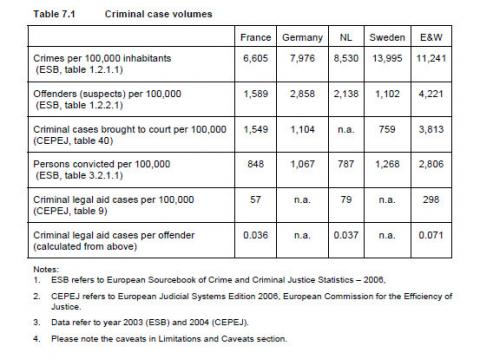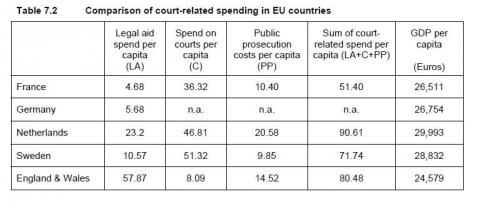Legal aid costs: Is there any justice in international comparisons
"Ken Clarke and his fellow ministers constantly attempt to legitimise cuts in legal aid by insisting that England and Wales have "much the most expensive legal aid system in the world". This argument is both inaccurate and misleading."
Des Hudson, Chief Executive, The Law Society, The Times, 24 June 2011
Following on from our look at the potential costs incurred by the reductions in spending on legal aid, several readers have written in asking us to explore claims about some potentially dodgy legal aid figures from the Ministry of Justice (MoJ).
The accusation came from Chairman of the Law Society Des Hudson in an article for The Times last week, reproduced on the website of the Sound off for Justice campaign website.
Justice Secretary Kenneth Clarke was challenged about the flawed comparison on this morning's Today Programme, and he maintained that despite difficulties comparing England and Wales with continental countries, a fairer comparison — with New Zealand — showed we still spent more.
So are the comparisons made sound? Full Fact went in search of the figures
Analysis
When we contacted the Law Society, they explained that Mr Hudson's criticisms were based on research actually done for the MoJ, available here.
The study does state that for both criminal and civil cases the amount paid in England and Wales was higher than other countries, based on analysis of data from 2000 to 2006.
There are however different ways of measuring the costs. The report looks at costs in the systems in Australia, Canada, France, Germany, Netherlands, New Zealand and Sweden compared to England and Wales. Both on a total spend and per capita basis, England and Wales were high up, if not top of these league tables.
There is "no escaping" the higher legal aid costs in England and Wales than elsewhere.
So what to make of these comparisons; are they "inaccurate and misleading"? Such strong words as these are not the words chosen in the MoJ report.
Rather than saying the comparison should not be made based on these figures, it states that "its findings were intended to be suggestive and provocative rather than definitive."
The information included comes with this caveat: "Making comparisons of international justice systems was complex due to significant differences in the methodology and reporting of data associated with justice systems. Therefore all comparisons in this report should be treated with care as to their interpretation."
But the report does not seem to rubbish the comparisons - rather, it sets out possible reasons for the cost that go some way to highlight why comparisons are difficult.
Volume of Cases
For criminal cases, the report explains that "the most important single factor in driving the high cost per capita of legal aid in England and Wales was the comparatively high number of legally-aided criminal cases." The difference in the volume of caseload is shown in the table below.

One reason offered for the higher caseload is comparatively higher crime rates, but it is not as simple as explaining the higher cost through higher crime. Other contributing factors include a high proportion of cases actually brought to court as well as the higher proportion of people eligible for legal aid.
"A possible driver of the high volume of legally aided criminal cases was the structure of legal aid eligibility rules. Countries with higher income ceilings in means tests for legal aid could expect higher spending levels per capita since a higher proportion of the population would qualify."
However a comparison of GDP per head and legal aid thresholds seems to suggest that this is "unlikely of itself to be a major factor" in higher costs in England and Wales.
In civil cases, the costs were also found to be high. However again the volume of cases was found to be a factor (such as a large volume of divorce cases in the UK). But as with criminal cases, the UK also spent a more per case.
For instance, while spending on non-family cases fell, there was a rise in the cost per case. Possible costs per case are suggested as "procurement arrangements and the composition of the caseload."
The Legal System
One of the problems raised about the comparison is that it relies on comparing different legal systems and there are different factors at play in different systems, which in turn impacts on legal aid costs.
As stated above, the figures suggest a higher proportion of cases are brought to court in England/Wales, New Zealand, and Canada, pointing to more cases being resolved without resort to a court hearing. This, it is claimed, gives continental legal systems a "comparative advantage" on legal costs.
But central to the problems raised about claims that England and Wales have a higher legal aid costs is that the issue should be looked at through the prism of costs to the legal system as a whole.
Because the English system is felt to have lower costs elsewhere in the legal system, this offsets legal aid costs to the extent that our system is not necessarily more expensive overall.
The report states: "Although legal aid costs in E&W were high, the costs of other elements of the Criminal Justice System were lower. The implication was that there might be a degree of substitutability between legal aid support and spending on courts." This is demonstrated in the table reproduced below, based on European Commission data.

It continues: "The legal system may have contributed to higher legal aid costs than on the continent, but these are balanced out by savings elsewhere in the legal system"
This is backed up by the Ministry of Justice Select Committee report earlier this year which, also based on European Commission data, suggested that "when the costs of courts, public prosecution services and legal aid are combined, the budget in England and Wales as a percentage of the GDP per capita is equal to the average."
Conclusion
Going over the report, it seems apparent that this isn't the damning indictment of international comparisons readers of the the Law Society article could have got the impression it was.
After all, the report's conclusion states: "There seemed no escaping the observation that legal aid in E&W was significantly more costly than elsewhere."
Those who question the use of the comparisons are right to point out that there are factors beyond the narrow issue of the legal aid system that drive these higher costs, such as the high volume of cases or the adversarial court system.
The point seems to be a subtler one. The report does not question the comparisons per se, it just questions how valid their use in a debate about bringing down the cost of legal aid really is.
After all, if a larger volume of cases or the adversarial system are significant factors driving the higher costs, then the scope of the debate about bringing costs down would need to be about much more than the legal aid system itself.